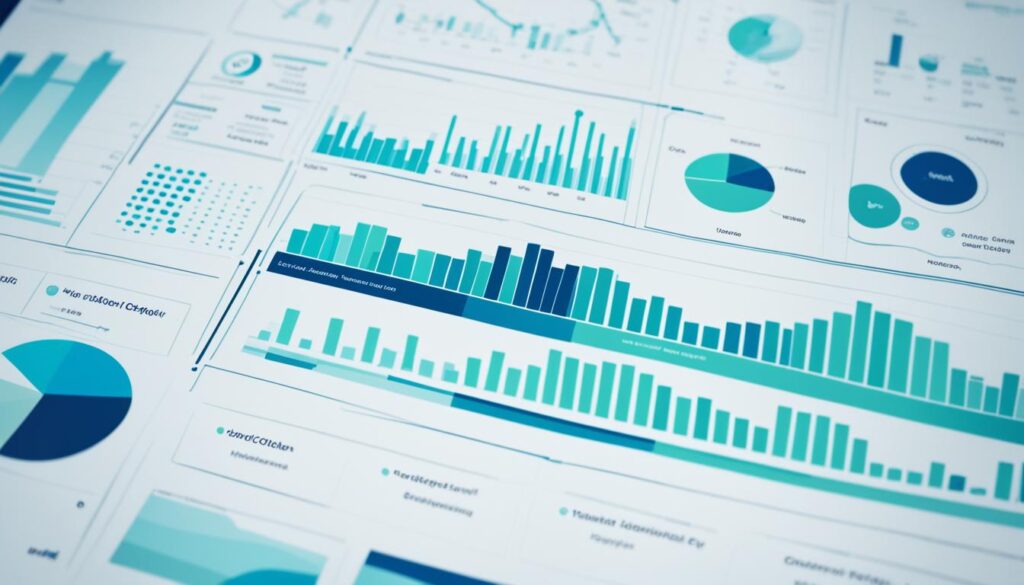Data-driven marketing automation is revolutionizing the way businesses interact with their customers. By harnessing the power of big data and utilizing automation tools, marketers can create personalized experiences that drive engagement and boost customer satisfaction.
With the ever-increasing volume of customer data available, it is essential to have a strategy in place to effectively utilize this information. Data-driven marketing automation allows businesses to gain valuable insights into customer behavior, preferences, and needs, enabling targeted campaigns and customized content that resonate with their audience.
In this article, we will explore the challenges faced in implementing data-driven marketing automation and how businesses can overcome them. We will also discuss the benefits of adopting a data-driven approach and creating a marketing strategy that leverages big data.
Key Takeaways:
- Data-driven marketing automation enhances customer engagement and improves marketing effectiveness.
- Challenges such as data silos, data quality, overwhelming data volume, implementation costs, and lack of vision can hinder the success of data-driven marketing automation.
- Choosing the right marketing automation tools and integrating them with a customer data platform (CDP) can help overcome implementation challenges.
- Data-driven marketing automation tools improve ROI by enabling hyper-personalization, automated campaign execution, real-time decision making, and data-backed insights.
- Creating a marketing strategy based on data requires systematic data collection, goal setting, audience segmentation, personalization, and continuous monitoring.
Challenges to Data-Driven Marketing Automation
Implementing data-driven marketing automation comes with its fair share of challenges. Let’s take a closer look at some of the key hurdles marketers face in this process:
- Data Silos: Organizations often struggle with data silos, where data gets trapped within different departments or systems. This lack of data integration hampers the effectiveness of automation processes, making it difficult to extract valuable insights across the organization.
- Data Quality: Maintaining data quality and consistency proves to be a significant challenge. Outdated or inaccurate data leads to misguided campaigns and ineffective automation. Without reliable data, marketers cannot make informed decisions and fully leverage the power of data-driven marketing automation.
- Overwhelming Data Volume: The sheer volume of data can be overwhelming, making it challenging for marketers to analyze and extract meaningful insights. Managing and processing large data sets requires robust tools and strategies to avoid getting lost in the vast sea of information.
- Implementation Costs: Implementing automation tools and integrating systems can be costly. Organizations must invest in the right technology and resources, which can be a deterrent for those with budget constraints. However, the long-term benefits of data-driven marketing automation often outweigh the initial implementation costs.
- Lack of Vision: Without a clear vision or strategy for automation, organizations may struggle to see the value and purpose of data-driven marketing automation. Having a well-defined plan is crucial for maximizing the benefits and ensuring a successful implementation.
“Data-driven marketing automation can transform businesses, but overcoming these challenges is essential for success.”
To address these challenges, marketers need to implement strategies that break down data silos, prioritize data quality, leverage advanced analytics tools, allocate resources effectively, and establish a clear vision for data-driven marketing automation.

Overcoming the Challenges in Data-Driven Marketing Automation
To overcome the challenges of data-driven marketing automation, businesses need to utilize the right marketing automation tools and integrate them with a robust customer data platform (CDP). Marketing automation platforms offer a wide range of features such as email marketing, lead nurturing, social media management, and analytics, enabling marketers to streamline their campaigns and improve efficiency. On the other hand, CDPs serve as a central hub that brings together customer data from various sources, creating a unified data repository.
By integrating these two technologies, businesses can ensure the availability of uniform and up-to-date data across their marketing systems, which is essential for the effective execution of automation processes. Without unified data, discrepancies and inconsistencies may arise, leading to ineffective marketing campaigns and wasted resources. Integration facilitates real-time updates that propagate changes throughout the system, ensuring that all marketing activities are based on the most recent and accurate data.
Data integration is not limited to internal sources; businesses can also leverage external data to enrich their customer insights. This integration of external sources enables companies to gather relevant information from third-party platforms, such as social media or market research databases, ultimately enhancing the effectiveness of their data-driven marketing strategies.

“Integrating data from various sources allows us to gain a holistic view of our customers. It enables us to deliver targeted, personalized experiences, and make data-backed decisions for our marketing campaigns.”
In addition to data integration, real-time updates play a crucial role in maintaining data quality. By capturing and processing changes as they occur, businesses can ensure that their customer profiles and behavioral data are always accurate and reflect the most current information. This enables marketers to make informed decisions and tailor their campaigns based on real-time insights.
The successful execution of data-driven marketing automation hinges on the ability to harness the power of integrated and up-to-date data. It allows businesses to deliver personalized experiences to their customers and drive meaningful engagement. By overcoming the challenges of data integration and leveraging real-time updates, marketers can unlock the full potential of data-driven marketing automation and achieve better marketing outcomes.
How Data-Driven Marketing Automation Tools Can Improve Your ROI
The combination of data-driven marketing automation tools can significantly enhance a company’s return on investment. By leveraging these tools, businesses can achieve hyper-personalization, automate campaign execution, make real-time decisions, and gain valuable data-backed insights.
Hyper-Personalization: With data-driven marketing automation, businesses can deliver tailored content and offers to customers, resulting in higher transaction rates and improved conversions. By analyzing customer data, marketers can segment their audience and create personalized experiences that resonate with individual preferences and needs.
Automated Campaign Execution: Data-driven marketing automation allows businesses to automate their campaigns, ensuring that the right message reaches the right person at the right time. By defining triggers and workflows based on customer behavior and preferences, businesses can increase lead generation and drive sales.
Real-Time Decision Making: Thanks to data-driven insights, marketers can make informed decisions in real time. By monitoring customer interactions and behaviors, businesses can adapt their campaigns instantly, optimizing for higher engagement and conversion rates. Real-time decision making enables marketers to stay ahead of the competition and deliver relevant experiences to their customers.
Data-Backed Insights: Data-driven marketing automation provides valuable insights that help refine marketing strategies and optimize results. By analyzing data from various touchpoints, businesses can gain a deeper understanding of customer preferences, identify trends, and fine-tune their marketing efforts for better performance.
“Data-driven marketing automation empowers businesses to deliver targeted, personalized experiences, automate campaign execution, make informed decisions in real time, and gain valuable insights to drive better results.”

| Key Benefits of Data-Driven Marketing Automation Tools |
|---|
| Hyper-Personalization |
| Automated Campaign Execution |
| Real-Time Decision Making |
| Data-Backed Insights |
How to Create a Marketing Strategy Based on the Data
Creating a successful marketing strategy based on data requires a systematic approach. By following these key steps, businesses can effectively leverage data to optimize their marketing efforts.
Data Collection
Start by collecting relevant data from various sources, including websites, CRM systems, social media platforms, and email campaigns. It’s important to gather comprehensive and accurate data to gain valuable insights into customer behavior, preferences, and interactions.
Goal Setting
Set clear and measurable goals for your marketing campaigns. Whether it’s increasing brand awareness, driving website traffic, or generating leads, defining specific objectives will help you focus your data collection efforts and evaluate the success of your marketing initiatives.
Audience Segmentation
Segment your audience based on demographics, behavior, and preferences. This allows you to tailor your marketing messages and create personalized content that resonates with different customer segments. By understanding your audience better, you can deliver more relevant and targeted communications.
Personalization
Utilize the data collected to personalize your marketing efforts. This can involve personalized email campaigns, customized website experiences, and targeted advertising. Personalization creates a more engaging and meaningful connection with your audience, increasing the likelihood of conversion and customer loyalty.
Continuous Monitoring
Monitor and analyze your campaign performance and key indicators on an ongoing basis. This enables you to identify trends, evaluate the effectiveness of your strategies, and make data-driven optimizations. Continuous monitoring allows you to adapt your marketing approach to ensure optimal results.
“Data-driven marketing strategies are essential in today’s digital landscape. By collecting and analyzing data, businesses can effectively target their audience and drive better marketing outcomes.”
By following these steps and continually refining your marketing strategy based on data insights, you can optimize your marketing efforts, improve customer engagement, and generate better results for your business.
| Benefits of Creating a Data-Driven Marketing Strategy | Examples |
|---|---|
| Improved targeting and personalization | Customized email campaigns that address specific customer pain points |
| Increased customer engagement | Interactive website experiences that encourage user interaction |
| Higher conversion rates | Targeted advertising campaigns that reach the right audience at the right time |
| Better ROI on marketing investments | Optimized marketing spend by focusing on high-performing channels |
By implementing a data-driven marketing strategy, businesses can unlock the full potential of their marketing efforts, maximize customer engagement, and achieve a competitive edge in the digital marketplace.
Conclusion
Data-driven marketing automation is a game-changer when it comes to enhancing customer engagement and increasing the effectiveness of your marketing strategies. By leveraging the power of big data and automation tools, businesses can create personalized and targeted campaigns that truly resonate with their audience. However, to successfully implement data-driven marketing automation, it is crucial to overcome the challenges that come with it.
One of the biggest challenges is dealing with data silos, where customer data is fragmented across different departments or systems within an organization. To address this, businesses need to invest in solutions that integrate and centralize their data, such as customer data platforms (CDPs). Additionally, ensuring data quality and accuracy is essential for successful automation. Employing strategies like continuous data monitoring and cleansing can help in maintaining high-quality data.
Implementing data-driven marketing automation also requires a clear vision and a well-defined marketing strategy based on the insights derived from big data. By analyzing customer behavior and preferences, businesses can segment their audience and deliver personalized experiences that drive engagement and conversions. Continuous monitoring of campaign performance and making data-backed decisions allows for ongoing optimization and improvement of marketing strategies.
By embracing data-driven marketing automation and building a marketing strategy around it, businesses can maximize their return on investment. The ability to deliver hyper-personalized experiences, execute automated campaigns, make real-time decisions, and gain insights from data can significantly improve customer engagement and overall marketing effectiveness. In today’s digital landscape, leveraging data-driven marketing automation is a competitive advantage that no business can afford to ignore.
FAQ
What is data-driven marketing automation?
Data-driven marketing automation is a strategy that uses big data and automation tools to create personalized and targeted campaigns, enhancing customer engagement and improving marketing effectiveness.
What are the main challenges of data-driven marketing automation?
The main challenges include data silos resulting from departmental divisions, maintaining data quality and consistency, overwhelming data volume, high implementation costs, and a lack of a clear vision or strategy for automation.
How can businesses overcome the challenges in data-driven marketing automation?
Businesses can overcome the challenges by choosing the right marketing automation tools and integrating them with a robust customer data platform (CDP). This ensures the availability of unified and up-to-date data, integration from external sources, real-time updates, and informed decision-making.
How can data-driven marketing automation tools improve ROI?
Data-driven marketing automation tools can improve ROI by enabling hyper-personalization, delivering tailored content and offers, increasing transaction rates and conversions, executing automated campaigns, generating more leads and sales, adapting campaigns based on real-time insights, and providing valuable data-backed insights for refining marketing strategies.
How can businesses create a marketing strategy based on data?
Businesses can create a marketing strategy based on data by collecting and integrating relevant data from various sources, setting clear goals, segmenting the audience based on demographics and preferences, continuously monitoring campaign performance, and optimizing marketing strategies based on data-driven insights.








